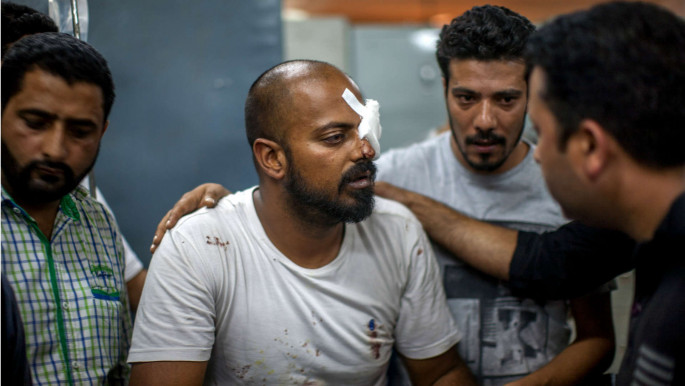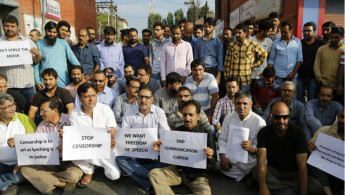Shooting the messenger- India's war against Kashmiri journalists
Whether they are authoritarian regimes like Syria or supposedly democratic systems like India, journalists have been hounded, detained and killed only for performing their jobs with integrity. According to a report by the New York based Committee to Protect Journalists (CPJ), around 1851 journalists and media persons were killed around the world since 1992.
In Indian-controlled Kashmir, a region that has been embroiled in a bloody conflict for more than 27 years, journalists are not alien to crippling interference and assault against them by the state authorities. Frontline reporters have been beaten and injured by the police and paramilitary forces while carrying out their professional duties.
In 2016, a year that was marked by widespread protests against what Kashmiris regard as India's military occupation, reporters faced the regular wrath of the Indian forces.
 |
We were frantically waving our cameras at the police personnel before they shot us |  |
Among them, two local photojournalists were targeted with pellet guns, one of whom was partially blinded. Zuhaib Maqbool and Muzzamil Mattoo were covering a protest in the capital city of Srinagar when they were targeted by pellet shotguns. Originally designed for catching prey, pellet guns have been used by Indian forces against unarmed protestors - despite regular calls to ban them from various international human-rights agencies.
"We were frantically waving our cameras at the police personnel before they shot us," Muzzamil Matto, one of the injured photojournalists, told The New Arab.
"This was a case of direct targeting because they couldn't have mistaken us for anyone else from less than 15 feet away."
 |
|
| Zuhaid Maqbool, a freelance photojournalist, lost sight in his left eye after being hit by pellets [Getty] |
More recently, Kamran Yousuf, a freelance photojournalist, was detained by India's National Investigation Agency (NIA), for allegedly throwing stones at the forces. The NIA, India's version of Homeland Security, still hasn't clearly spelled out the charges leveled against Yousuf after more than a month's detention - other than a vague reference to stone-throwing.
The Campaign to Protect Journalists has called for Yusuf's immediate release and demanded the Indian authorities stop trying to crush the Kashmiri independent press.
"We are still unsure of what exactly Kamran has done to warrant detention. He was only doing his job," Rubeena Yusuf, Kamran's mother, told The New Arab.
"I am a single mother, barely trying to make ends meet, and do not have the resources to take legal recourse against the all-powerful NIA," she added.
Perhaps realizing the power of images in heightening awareness and even inspiring political mobilization, Indian forces have recurrently targeted Kashmiri photojournalists in particular.
According to Showkat Shafi, who works as a photojournalist for Al Jazeera network, photojournalists are more prone to assault because they have to be necessarily present at the frontline for carrying out their jobs. Shafi was himself beaten and detained in 2011 by Indian police while taking pictures of a protest demonstration.
In 2016, all local newspapers were banned from publishing for three days. Following that, Kashmir Reader, a local English-daily, faced a separate gag. The act was widely criticized and Amnesty International called it a setback to free speech.
Read more: Kashmir and the festering legacy of partition
And on top of this, the frequent blanket-bans on the internet in Kashmir hampers journalistic activities across the region. During the widespread protests last year, mobile internet was suspended for months. Up to July of this year, around 10 cases of internet shutdown were recorded in Kashmir.
"Due to internet blackouts, it becomes nearly impossible to report breaking news," Saqib Mir, who works for Kashmir Life, an online news portal, said. According to Mir, the regular throttling of internet speeds by Indian authorities also makes it difficult for reporters to send pictures and video reports.
Solidarity with Kashmiri journalists from their Indian counterparts has generally been cold.
 |
Due to internet blackouts, it becomes nearly impossible to report breaking news |  |
"The Press Council of India, in the past two decades, has not even issued statements condemning the assaults, injuries and killings of over a dozen Kashmiri journalists who died in the line of their duty," Majid Maqbool, the editor of Kashmir Ink, a weekly magazine, told The New Arab.
According to Maqbool, massive state surveillance makes it extremely difficult for Kashmiri journalists to report and write freely.
As brave and unflinching as they are, Kashmiri journalists need to be shielded from this concerted effort to limit the scope of their work. Trying to put a veil over the abuses perpetrated in Kashmir will not magically make the conflict disappear.
This ostrich-like approach of the Indian state needs to be replaced with a culture of total transparency and freedom of the press. Shooting the messenger will only exacerbate Kashmir's lethal conflict and further delay its resolution.


![President Pezeshkian has denounced Israel's attacks on Lebanon [Getty]](/sites/default/files/styles/image_684x385/public/2173482924.jpeg?h=a5f2f23a&itok=q3evVtko)



 Follow the Middle East's top stories in English at The New Arab on Google News
Follow the Middle East's top stories in English at The New Arab on Google News


